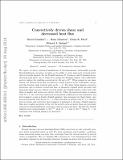| dc.contributor.author | Goluskin, David | |
| dc.contributor.author | Johnston, Hans | |
| dc.contributor.author | Spiegel, Edward A. | |
| dc.contributor.author | Flierl, Glenn Richard | |
| dc.date.accessioned | 2017-01-09T18:57:51Z | |
| dc.date.available | 2017-01-09T18:57:51Z | |
| dc.date.issued | 2014-10 | |
| dc.identifier.issn | 0022-1120 | |
| dc.identifier.issn | 1469-7645 | |
| dc.identifier.uri | http://hdl.handle.net/1721.1/106298 | |
| dc.description.abstract | We report on direct numerical simulations of two-dimensional, horizontally periodic Rayleigh–Bénard convection between free-slip boundaries. We focus on the ability of the convection to drive large-scale horizontal flow that is vertically sheared. For the Prandtl numbers (Pr) between 1 and 10 simulated here, this large-scale shear can be induced by raising the Rayleigh number (Ra) sufficiently, and we explore the resulting convection for Ra up to 10[superscript 10]. When present in our simulations, the sheared mean flow accounts for a large fraction of the total kinetic energy, and this fraction tends towards unity as Ra→∞. The shear helps disperse convective structures, and it reduces vertical heat flux; in parameter regimes where one state with large-scale shear and one without are both stable, the Nusselt number of the state with shear is smaller and grows more slowly with Ra. When the large-scale shear is present with Pr≲2, the convection undergoes strong global oscillations on long timescales, and heat transport occurs in bursts. Nusselt numbers, time-averaged over these bursts, vary non-monotonically with Ra for Pr=1. When the shear is present with Pr≳3, the flow does not burst, and convective heat transport is sustained at all times. Nusselt numbers then grow roughly as powers of Ra, but the growth rates are slower than any previously reported for Rayleigh–Bénard convection without large-scale shear. We find that the Nusselt numbers grow proportionally to Ra[superscript 0.077] when Pr=3 and to Ra[superscript 0.19] when Pr=10. Analogies with tokamak plasmas are described. | en_US |
| dc.description.sponsorship | National Science Foundation (U.S.) (Award AST-0708106) | en_US |
| dc.language.iso | en_US | |
| dc.publisher | Cambridge University Press | en_US |
| dc.relation.isversionof | http://dx.doi.org/10.1017/jfm.2014.577 | en_US |
| dc.rights | Creative Commons Attribution-Noncommercial-Share Alike | en_US |
| dc.rights.uri | http://creativecommons.org/licenses/by-nc-sa/4.0/ | en_US |
| dc.source | arXiv | en_US |
| dc.title | Convectively driven shear and decreased heat flux | en_US |
| dc.type | Article | en_US |
| dc.identifier.citation | Goluskin, David et al. “Convectively Driven Shear and Decreased Heat Flux.” Journal of Fluid Mechanics 759 (2014): 360–385. | en_US |
| dc.contributor.department | Massachusetts Institute of Technology. Department of Earth, Atmospheric, and Planetary Sciences | en_US |
| dc.contributor.mitauthor | Flierl, Glenn Richard | |
| dc.relation.journal | Journal of Fluid Mechanics | en_US |
| dc.eprint.version | Original manuscript | en_US |
| dc.type.uri | http://purl.org/eprint/type/JournalArticle | en_US |
| eprint.status | http://purl.org/eprint/status/NonPeerReviewed | en_US |
| dspace.orderedauthors | Goluskin, David; Johnston, Hans; Flierl, Glenn R.; Spiegel, Edward A. | en_US |
| dspace.embargo.terms | N | en_US |
| dc.identifier.orcid | https://orcid.org/0000-0003-3589-5249 | |
| mit.license | OPEN_ACCESS_POLICY | en_US |
